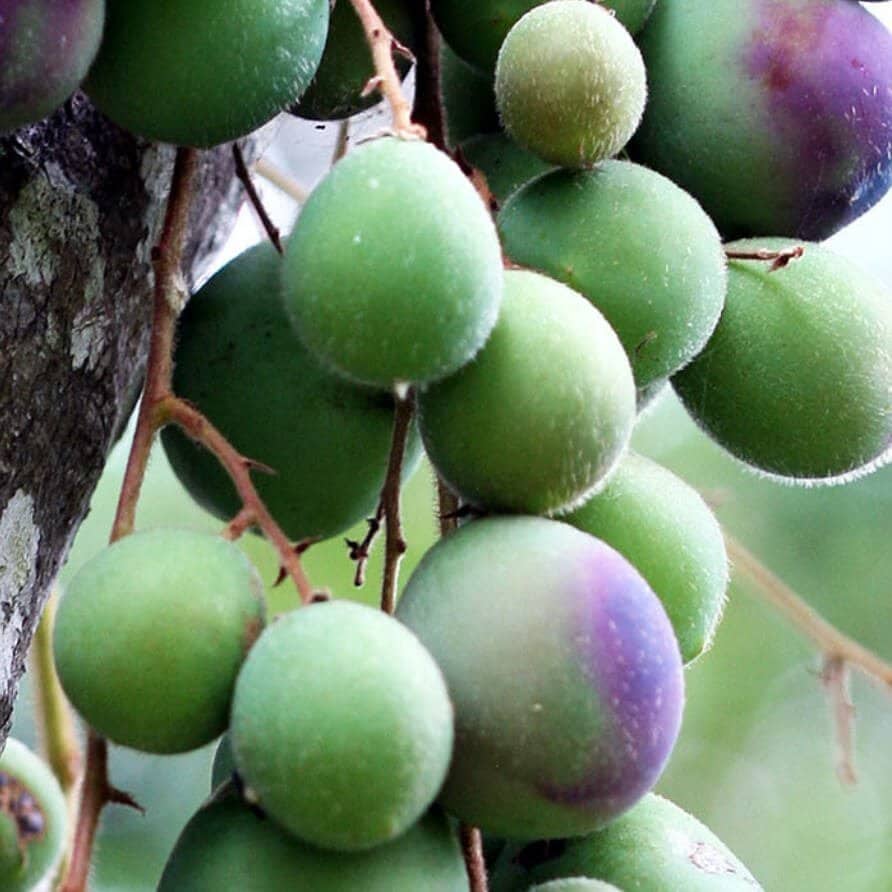Bush Apples (Syzygium suborbiculare), often known as Djarduk, are members of the lilly pilly family. It is a small, under storey tree found across open forests and woodlands of Northern Australia and grows to a height of 4 to 20 metres. The trees are distinguished by their large dark leaves, small white flowers, and vibrant pink apple-sized fruits, which drop to the ground and are harvested when ripe. The trees are extremely tolerant of fire, and will sprout new growth if burnt. The tree flowers in July-November and produces fruit in October-February and flourishes in tropical conditions. The seed is quite large with only a small amount of flesh on the outside. The fibrous flesh can be tinged with purple and red hues.
Aboriginal people eat the fruit raw and occasionally wrap them in paperbark for roasting on the fire. The tree is also used for its medicinal properties, as firewood and also provides a nectar source for bees. Within Aboriginal culture the fruits are eaten raw and the juice of the cooked apple used to relieve sore throats, coughs and ease congestion.
In previous times the Indigenous people would follow the bush foods, moving from rainforest to the floodplains and seaside to creeks. When the Bush Apples were flowering it was a sign to move there.
Rich in antioxidants, the juice of the cooked fruit is used to sooth inflamed throats, treat coughs and relieve congestion. The leaves can be made into a tea for the treatment of stomach problems and heated leaves are applied to wounds to reduce bleeding and swelling. The juice and pulp can be placed in the ear to relieve ear ache.
While it looks like an apple, the Bush Apple tastes more like a pomegranate – only fluffy! The fruit’s skin is crunchy and tart, while the flesh inside has a tangy taste. There’s not much fruit inside that skin either; but there’s a large seed!
A complex flavour that is predominantly sweet but with a tangy, rose-like flavour and mildly tart finish. Often described as a cross between an apple and a pomegranate. The flavour can range from sweeter to sharper depending on their proximity to salt or fresh water. The overall mouth feel is more like a pomegranate than an apple.
The Bush Apple has a clean, sweet, floral aroma with the slightest hint of eucalypt. The extract exhibits a pleasant, crisp, sweet apple perfume.
The Bush Apple has in recent years caught the attention of world class chef’s. The acidic but sweet complexity of the flavour lends the fruit to applications in a large range of dishes. The fruit contains only a thin layer of flesh surrounding a large seed. The edible portion of the bush apple is fluffy in texture on the inner side while exhibiting a crunchy texture on the outer side.
Try it in classic apple desserts such as apple pie, apple crumble, strudel, or baked desserts. Create a fruit chutney or jam or use as a perfect crisp and sweet addition to salads. Also suitable as a sauce for pork, poultry or savoury recipes. Combine with Granny Smith apples for a more complex combination of flavours.
The sweet yet acidic fruit is a great addition to sorbets and ice creams – Melbourne chef Ben Shewry uses Bush Apple in his renowned black ant lamington at his Attica restaurant!
The Bush Apple also works well in cordials. Add a shot of vodka or gin for a next-level cocktail!










